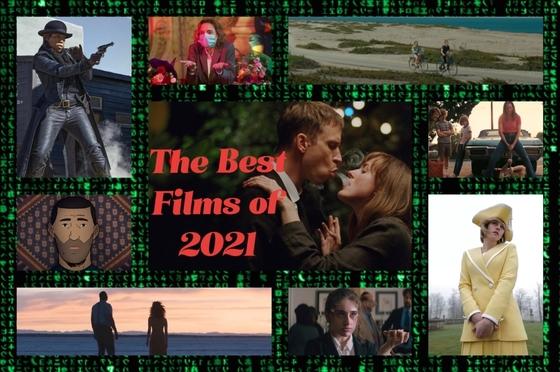
At the start of 2021, the year was feeling a bit like 2020 Continued. Covid continued to rule our lives in some way that we all hoped would end with the rollout of the vaccine. Now that we are approaching 2022, it seems that… it still is. Even though we now have vaccines.
One thing that the year brought to us? The full return of movie theaters. Some people rolled the dice last year to see what I’m sure became an all-time favorite, The War With Grandpa. Most audiences, however, decided to wait for the new year and mass produced protection in the form of two shots in the arm. While many remain uncomfortable by the idea of returning to the theater, those who ventured out were met with some wonderfully unique experiences. While last year had a great number of films that we loved (The 12 Best Films of 2020), this year brought us even more. Whether you watch these movies at home or take the trip to your local theater, we feel confident that you will be able to find something to love in our list.
2021 Runners-up (featured in the image above): The Worst Person in the World, Bad Luck Banging or Loony Porn, Red Rocket, Licorice Pizza, Spencer, Shiva Baby, Nine Days, The Harder They Fall, and Flee.
Now without further ado, we present our Top 15 Films of 2021…
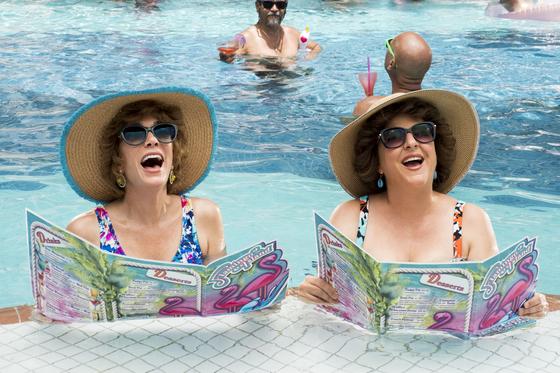
15. Barb and Star Go to Vista Del Mar
After a year stuck inside with nothing to do but wait for our bleak future to come, Barb and Star Go to Vista Del Mar became the perfect get-away upon its early February release. While the film’s cinematic qualities do not warrant its spot as one of the best films of the year, we wanted to honor Barb and Star Go to Vista Del Mar for being the stand-out comedy of 2021. In a year with little to laugh about, Barb and Star provides a memorable escape, beaming with camp and a colorful cast of characters that inhabit the middle age midwestern utopia that is Vista Del Mar. Kristen Wiig and Annie Mumolo star as the title characters and while their whimsical performances bring laugh after laugh to the film, their charmingly absurd screenplay is the star of the show.
Barb and Star takes place after two lifelong friends leave their Midwestern town for the first time to travel to the magical fictional Florida coastal city of Vista Del Mar. Paradise is quickly lost as the two compete over the same man and are forced to save the town from its imminent doom. The film rains unexpected jokes, with a resilient commitment to absurdity. Barb and Star never takes itself too seriously but brings an uproar in humor by allowing the serious moments to be seen as absurd. At a time where the comedy genre reigns supreme on television and is all but dead in feature-length films, the originality of Barb and Star Go to Vista Del Mar brings hope that the cookie-cutter comedies of the 2000s have seen their day and humor based on creativity will pave the way to a funnier tomorrow. -Jonah Desneux

14. A Cop Movie
Perhaps the most fascinating film of the year was the quasi-documentary, A Cop Movie. To describe it in an accurate way, I would risk spoiling the audacious filmmaking decisions that make the film what it is. To avoid this, I will instead urge you to give this a watch on Netflix.
Director Alonso Ruizpalacios documents two police officers living and working in Mexico City. We ride along as they respond to calls from citizens desperate for help in an area where those in power must first ask, “what’s in it for me?” It is a heart-pounding film that depicts moments of heroism without leaning into Copaganda. Ultimately, the police force in Mexico City, like so many in our own nation, is full of corruption. From the top to the bottom, people are looking out for themselves. Despite what may be good intentions when joining the force, officers must adapt to the broken system or risk the consequences that may cost them their lives. -Logan Van Winkle

13. Annette
Musicals reign supreme in 2021(four make this very list) but none come close in originality to The Sparks Brother’s Annette. The eccentric Leos Carax takes the wheel directing the ambitiously absurd rock opera and brings to life this year’s most beloved character, Baby Annette. Annette is part passion, part parody, and an abundance of enthralling nonsense. The film is full of unorthodox choices, making it a musical experience unlike any other, playfully mocking the seriousness of song and dance amid one of cinema’s most musical years.
Annette’s farcical tour begins with Carax speaking to the audience like a director before the start of a stage show. Then, after a barrage of convoluted editing and sounds, the cast and crew assimilate and make their way to the theater, asking for permission to begin, with the song “So May We Start.” The song plays no significance to the plot but introduces us to our leading men and women, whose natural voices clearly heard, juxtaposed to the grand chorus found in rock operas, with a splash of a children’s choir on the side. The prolific stand-up comedian Henry McHenry (Adam Driver) and his famous opera-singer wife Ann (Marion Cotillard) are at the helm of the dramatics. We instantly know that they love each other so much, as they repeatedly sing those very words to each other in their out-of-key ballad “We Love Each Other So Much.” Carax is unflinching in portraying the absurd through a serious lens and takes risks that bind Annette to the top of some worst movies of the year lists. However, when demolishing your guard and embracing the humor of the work, Annette takes the road least traveled owning the purposefully bad, as Carax, Driver, Cotillard, and puppet baby rewrite what makes a musical magical. Annette is one of cinema’s greatest parodies and does to the musical what Jean-Luc Godard did to the romance drama with Contempt. -Jonah Desneux

12. Malignant
I cannot overstate how unprepared for Malignant I was. On the way to the theater, my girlfriend said, “I don’t really know what this is about.” To which I said, “Neither do I. All I know is that it’s from the director of Saw, Insidious, and The Conjuring and that it’s a scary movie.” I can’t imagine a better way to watch this movie. Because of this, I will say absolutely nothing about the plot.
About five minutes into Malignant, I had a troubling thought. The kind you never want to have so early into an almost two hour long movie… “This is really bad.” I meant it too. But then a funny thing happened. As the movie continued, slowly but surely, I changed my mind. I began riding its wavelength and everything made sense. It began as “this isn’t so bad.” But by the end, it turned into a full on “I loved that movie!” I cannot think of a single movie in my life where I have had such a strong turnaround in the opening moments to the end credits. Malignant is so charmingly campy and over the top, it is impossible not to be won over. The choices in the beginning of the movie that had me scratching my head were perfectly in line with the film I came to appreciate by the end. Everything was intentional. As soon as I could step back and see the full picture, the genius of James Wan became crystal clear. This is easily the most fun I had in a theater all year and if you are a fan of horror, I cannot recommend Malignant enough. -Logan Van Winkle

11. Zola
Those who relegate Zola to simply being a movie about a tweet are the same people who say that The Social Network is about Facebook. The subject may stem from social media, but these films are much more than capitalizing on a trend. They are statements of the current changing times and cultural commentary over the obsession with online image and influence. While The Social Network takes us into the highbrow world of Harvard, Zola transports viewers into a world of strippers, pimps, and Florida.
The events of Zola are inspired by the real life misadventures of A’Ziah “Zola” King (Taylour Paige), whose tumultuous trip with fellow stripper Stefani (Riley Keough) became one of the internet’s greatest stories of shock and awe following King’s infamous twitter thread. Janicza Bravo directs the A24 drama, keeping King involved with the film and her story as an executive producer. The two successfully capture the madness in Zola, with the money making trip to Florida and the Brutus sized betrayal. Paige excels in exemplifying Zola’s wit and daring demeanor, while Keough carefully weaves the extreme charisma and selfishness of Stefani, giving one of the most memorable performances of the year. As the two actresses keep the audience entertained, Bravo’s creates a smutty color pop infused world, perfect for a modern day cautionary tale. Zola is full of grit, humor, and cleverness from the characters and the direction. Bravo does not shy away from the folly that resides in the underbelly of society, while never straining empathy from sex workers. Stereotypes do not drive the characters’ actions. Instead, we see the characters as individuals who, like all of us, have flaws hidden in the initial image they present. -Jonah Desneux

10. Last Night in Soho
2021 saw the release of what is likely Edgar Wright’s most divisive film yet. Despite many of our colleagues not enjoying his latest film, Jonah and I did the impossible and found common ground on Last Night in Soho. Set partly in present day London and partly in 1960s London, the film tells the story of a young fashion student who begins seeing visions of the past. They begin innocently fantasy-like – at first, but quickly turn much more sinister. More than any of his previous films, Last Night in Soho is a true technical marvel.
Wright’s style is often highlighted with quick cuts and frenetic editing. Last Night in Soho, on the other hand, finds its own voice in its design. Recreating 1960s London – the glitz, the glamor, and even the danger lurking beneath the surface in a truly stunning manner, the production design is top-notch and some of the best of the year. The two leads, Thomasin McKenzie and Anya Taylor-Joy, keep this ghost story from feeling familiar and help to make it one of the most watchable movies of the year. A peculiar choice made near the end of the film was a bit baffling, considering the rest of the film. But everything preceding it is filmmaking at its finest and made for one of the most memorable theater experiences that I had this year. -Logan Van Winkle

9. Titane
In the age of nonstop reboots, franchises, and now metaverses, there is an intense longing for flashy films with originality. As IP Surprises run supreme on the big screen, the stories you’ve never seen slumber in the soft-spoken art-house drama. We love them, they’re the best, but there is still a deep hunger for a theatrical spectacle that doesn’t rely on an established hero. Lucky for us, French Auteur Julia Ducournau prepared us an unforgettably thrilling meal with Titane. Ducournau’s level of controlled chaos is remarkable for her second feature film. Winning this year’s Palme d’Or, Titane continues the current wave of French ultra-violence and body horror, underlined as a family drama composed of themes of gender fluidity, technical evolution, body dysmorphia, and unconventional empowerment.
Titane is a lot, visually and narratively, but Ducournau seamlessly holds her unpredictable story together through her great trust in Agathe Rousselle, playing Alexia, who currently holds the crown of this year’s greatest anti-hero. From the start Ducournau challenges her audiences with scenes of violent horrors that are so visually pleasing, morals become numb, succumbing to the corrupt entertainment. Alexia, with a titanium plate in her head following a near-fatal car crash, is a catalyst for the ever-evolving nature of identity, as their story is an odyssey from night clubs to a community of first responders. The characters harbor dark secrets, but Ducournau leaves them open and vulnerable, in human nature’s most notable quest of wanting to love and be loved. Titane is a psychological thriller mixed with surreal imagery and metaphors. Its very existence may be too much for some, but its exuberant presence sopping with originality satisfies a much-needed craving in the cinema’s current state. If you can get past the graphic car sex, which is insane but more importantly necessary, then I employ you to let Titane and all of its surreal glory get stuck in your head like a large metal plate. -Jonah Desneux
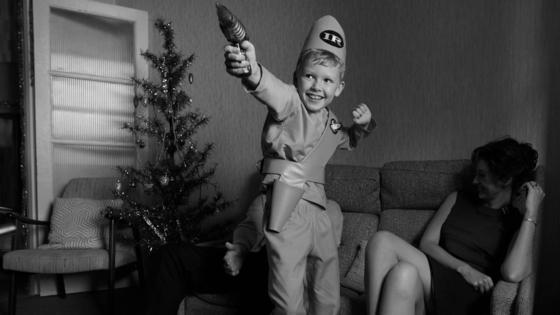
8. Belfast
I am a sucker for movies about children. After years of working with them, I think they are the most fascinating creatures on the planet. Belfast already had this in its favor going in. What really tipped it over the edge was the pint-sized ball of charisma that is Jude Hill. Hill plays Buddy, the young boy whose eyes we see the world through.
Despite being surrounded by unrelenting fear spurred on by war, financial instability, and unclear futures, Buddy maintains a positive outlook that brings out the best in those he encounters. The love that he shares with his family, especially his Granny (Judi Dench) and his Pop (Ciarán Hinds), feels so personal to writer-director Kenneth Branagh and yet infinitely relatable. If you’re not sold on the movie just yet, please note that there is a scene that revolves around Caitriona dancing as Jamie Dornan sings “Everlasting Love”. That scene, like the movie itself, is an absolute joy to watch. -Logan Van Winkle
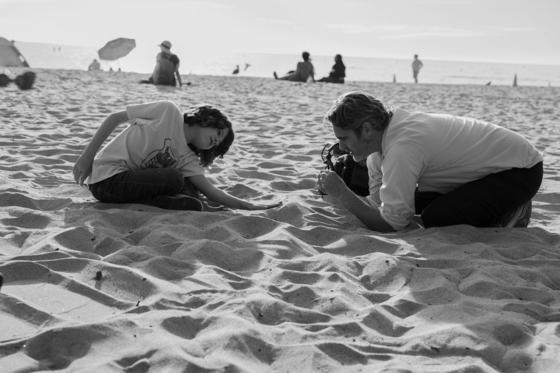
7. C’mon C’mon
Ah Mike Mills, you everyday drama King. C’mon C’mon is Mill’s follow-up to his 2016 release 20th Century Women, furthering his style of capturing and examining the simplicities and absurdities of modern life. Mills goes all in with his style in C’mon C’mon, examining the wonder and the ordinary of the world through explaining it to a child. Joaquin Phoenix plays Johnny, a radio journalist responsible for looking out for his joyfully strange nephew Jesse (Woody Norman) while his mother, Gaby Hoffmann, who delivers an immensely underrated performance, leaves LA to care for Jesse’s father (Scoot McNairy) mid manic episode. The film centers around Johnny and Jesse’s relationship and while Phoenix gives one of his best performances, Jesse’s curious mind is the film’s driving force. Norman captures Jesse’s eccentricity with the youthful spark needed to both love and frustrate as if he were your own.
C’mon C’mon is a delicate lesson on life, but captivates not from the beauty of our puzzling world, but from the magic of its discovery. Mills presents the film in black and white, replicating his philosophy on accepting the complex. The film is scientifically spiritual, leading to a serene meditation, not on the unknown, but for a comforting appreciation for what we do. In framing the film in fragments of memories and childhood lessons, the inherent complexities melt away to rebellious scenes of gratitude, not subjected to social and cinematic norms. Johnny and Jesse guide the audience through a journey of acceptance, notably that of our emotions. Though we wear our identities like masks, and at a young age feel like the mask of masculinity is the most important, Mills strips the need for emotional strength, to instead embrace the acceptance of feeling the way you feel. We see this in the film’s cathartic “climax” as Johnny and Jesse scream their emotions in the park, and though the message is not subtle, Mills basks in not needing subtlety when creating comfort towards our greatest uncertainties. -Jonah Desneux
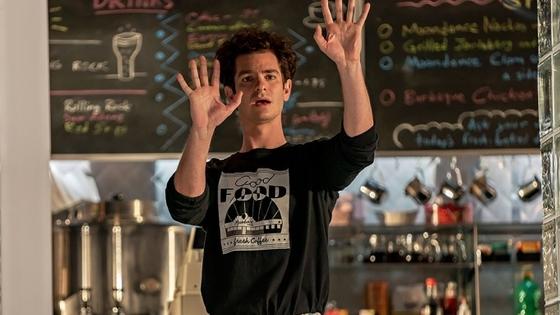
6. Tick, tick…BOOM!
No other movie in 2021 brought me the amount of joy that tick, tick… BOOM! did. As you can tell from this list, we are no strangers to the movie musical. This year had an abnormal amount – some more successful than others. None are as committed to a lead performance this year as Andrew Garfield is portraying Jonathan Larson. Magnetic, exhausting, and surprisingly physical, Garfield is 100% on from beginning to the end.
Larson is so deeply consumed in his art and his own measurement of success that he is constantly letting his relationships fall by the wayside. Despite the character making selfish and, at times, frustrating decisions, Garfield brings a sense of humanity to him that makes him impossible not to root for. His manic energy lends itself perfectly to the upbeat musical numbers, while his naturally empathetic qualities lend themselves to the slower, quieter moments. It’s a testament to his performance and the film itself that it is easily the 2021 movie that I have watched the most. It has quickly become a comfort film and will be for years to come. -Logan Van Winkle

5. The Green Knight
Marvel movies might be back, but The Green Knight is this year’s greatest hero film. Not only is The Green Knight the best of the over-the-top bunch, but it is also what the inevitable “Every Action Character Ever Made Cinematic Universe” should aspire to be when telling a hero’s journey. In a fantasy retelling of the medieval story of the Green Knight, Dev Patel plays Sir Gawain, the ambitious yet unproven nephew of King Arthur. To begin his procrastinated legacy, Gawain accepts the Christmas Day challenge of the mysteriously imentidating Green Knight and cuts off his head in front of the knights of the round table. Gawain’s honor comes at the price that a year later he must travel to the Green Knight who will return the blow to the nape of the neck. Gawain’s act is the compelling combination of bravery, lunacy, and the determination to be known. The film follows Gawain’s journey to fate, painting the portrait of a character with mortality and damning ignorance, that warrants empathy through his relatability, despite the fantastical story and setting. Unlike the other heroes whose shoe-horned drama is never earned and always comes second to their God-like image. Director David Lowery gives The Green Knight authentic stakes for audiences to follow. At the end of the film, it will be life or death for Gawain, with no one to swoop in to save the day before consequences are dealt, negating the drama built before it, much like our own existence and the mortal march to death we face every day.
Lowery dresses his film as a fantasy spectacle, filled with mesmerizing imagery and compelling costumed characters, but the film’s power comes from the relatability of one’s journey to death. Gawain sets out to bring worth to his name, growing through his troubles and triumphs, interacting with those who help and those who hurt, all to come to the inevitable end to examine not just the worth of his name, but the cost of his journey. Lowery does not spoon-feed the answers, because there are no answers to the inevitabilities of life. We are left to reflect on what it all means to us, and for The Green Knight to capture this simplicity on such a grand scale, is a feat of filmmaking that is far easier to dream than to create. The technical aspects, along with a cathartic viewing experience, make The Green Knight one of the best films of the year and further establishes Lowery’s own legacy as one of the greatest living filmmakers. -Jonah Desneux

4. Bo Burnham: Inside
It feels obvious to say that Bo Burnham: Inside is the quintessential Covid movie. But then, I never claimed to shy away from stating the obvious. After stepping away from the keyboard in 2016, Burnham had planned his grand return to the stage in 2020 before, as he states, “the funniest thing happened.” What follows is one of the most deeply personal and introspective comedy specials put to film.
From beginning to end, Burnham is completely and totally isolated. During this (everybody say it with me!) unprecedented time, it is clear that he needs to regain control of some aspect of his life. Burnham proceeds to write, perform, and record a performance that is unlike any other. With an immense amount of vulnerability, Inside often acts as more of a documentary about making a comedy special than a comedy special itself. Mixing humor with a very real sense of anxiety, fear, and dread seems to allow Burnham to come to terms with his current situation in a way that we can only hope was as cathartic for him as it was for us. -Logan Van Winkle
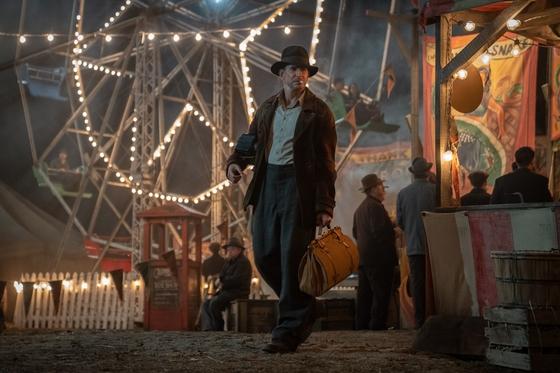
3. Nightmare Alley
Guillermo del Toro’s remake of the 1947 noir Nightmare Alley is a rare example of a remake finding greatness in the retelling of an entrancing story, while simultaneously creating its own immaculate image. Del Toro treads this fine fine line by perfectly matching the auteur’s magical realistic style and imagery, with a mastery of noir storytelling. No one is better at creating a fantasy fairytale than Del Toro. The genre has become uniquely his own. While he continues to share his cinematic fables to great acclaim, to the point of winning the Oscar for The Shape of Water, Del Toro boldly combines his imaginative filmmaking with a treasured relic of the past, creating a film juxtaposed with magic and grit, that ultimately proves to be the perfect match for each other.
Film Noirs are rarely regarded as fables, yet contain all the elements of one, parading in the sleek dark style to tell a tale of morals. Neo-noirs often focus on a modern detective, but Del Toro treats us in bringing back the noirs of cons and the artists who commit them. Nightmare Alley contains luxurious locations to give the characters the glamor they desperately desire, while maintaining the grim nature of crime and the human psyche. Without giving into total darkness, Del Toro breaks away from the bleak original material to create another world of wonder. Though the magic may not be real, like in Del Toro’s previous works, the imagery of a 1940s carnival brings about the unspoken preternatural atmosphere the director is known for. Bradley Cooper’s Stanton Carlisle, a hard-boiled man down on his luck haunted by his past, finds the fair, mesmerized by the pleasing oddities along with the audience. Del Toro lets us play around in this world, his world, that becomes home as we become familiar with our fables characters and their desires. As one does when they mature and age, we leave our home for grander ventures and follow Stanton into the city where the film takes shape as a full throttle noir. Cate Blanchett comes into play fulfilling her destiny as a traditional hot blooded femme fatale. With memories of home-present Rooney Mara’s character Molly. Del Toro balances Stanton’s journey, along with the film’s dramatically different genres and visual appeal. The results are a wondrous achievement in pure entertainment. The film’s themes and ideas resonate throughout, but Nightmare Alley is more than just ideas and themes found in all the best films. It is entertainment we strive to escape in, but often can not. This is not the type of Disney entertainment that brings back recognizable faces to sell nostalgia over story. Nightmare Alley is entertainment that comes from the transcendental cinematic experience of getting lost in a world crafted to perfection by one the world’s greatest creative minds and a plot of pure psychological pleasure. -Jonah Desneux
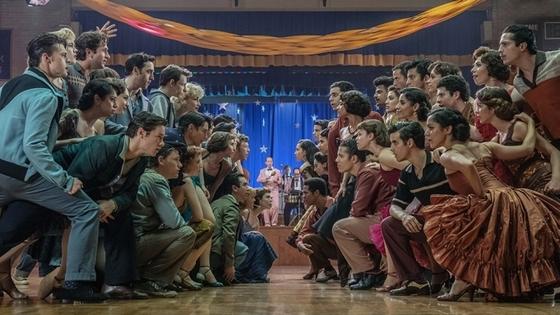
2. West Side Story
There are few things that can fill your heart with as much joy as watching someone who is really good at something be really good at that thing. When Steven Spielberg announced that he would be making his own adaptation of West Side Story, many people were hesitant. It’s West Side Story! One of the most beloved Best Picture winners ever! Why would you even attempt to make your own version? Believe it or not, Spielberg knows what he is doing. His (somehow) first ever musical is a glorious spectacle of song and dance.
From the moment the film begins, and we are introduced to the Jets and their leader, Riff (played by the fantastic Mike Faist) it is clear that the audience is in for a treat. For two and a half hours, Spielberg recreates the magic of classical Hollywood. Every shot dazzles with imagination and every camera movement has purpose. When so many filmmakers seem to be painting by numbers, he comes in to remind us how good movies can truly be when you utilize the entire canvas. The excellence of West Side Story does not stop behind the camera. In front of it, the cast is extraordinary. Beyond the aforementioned Faist, the tale is brought to life by Ariana DeBose, David Alvarez, and a star-making turn from Rachel Zegler. To top it all off, Rita Marino is there to pass the torch to this new generation of stars. For every second of this film’s 156 minute runtime, they carry it well. -Logan Van Winkle
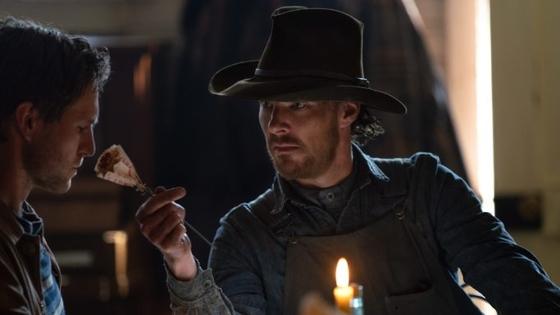
1.The Power of the Dog
Cinema survived 2020, cinema thrived in 2021. Cinema has shown once again, its ability and importance to stay present as the world turns upside down. Technological advancements, pandemic regulations, uncharted disruption practices, and a plethora of essential new voices, have developed the ways currently cinema looks, but the relentless desire for artists to tell their stories and audiences to consume these stories to learn, escape, and evolve proves that the burning light of motion pictures will never be extinguished. As long as there are stories to share, films will be the finest way for the soul to enjoy them. Jane Campion’sThe Power of The Dog is a testament to this nature, as it encapsulates the vital elements in empathetic storytelling that can only be found in film. In a mere 2 hours, Campion presents an engaging fabula, to appease the art house crowd who are allowed to playfully pick out hidden metaphors, subtle foreshadowing, devour themes too risque for the mainstream, while Campion’s uses subtext to tell the unseen life of a sad angry man and the men sad and angry men he represents. If not looking for an active viewing experience, Campion’s exceptional craftsmanship, can keep even the most casual of viewers enthralled by the complicated performances, cinematography glazed in beauty among devious spirits, and a mystery that is so brilliantly laid out that the end is not only satisfying, but burrows into the consciousness mind like a parasite in a sick animal. Campion provides answers to appease the needy mind, but presents questions for one to think about and take part in the communal aspect of cinema of sharing beliefs with others. Everything is done with a purpose and Campion uses editing and cinematography, to exemplify the language of cinema that can not be duplicated in other mediums. The film is about a cruel self-loathing rancher (Benedict Cumberbatch), his relationships, his reasons, and the games played for control and peace. The lines of good and bad are gray, as the film blurs the lines of reality and the identities we give ourselves to make sense of it. The Power of Dog brings about the spirituality of cinema, while taking on spirituality itself. -Jonah Desneux





Comments on this entry are closed.